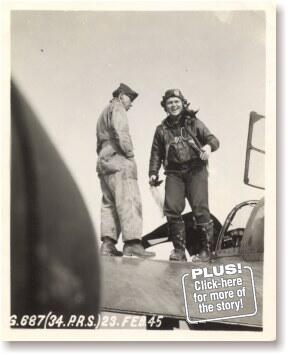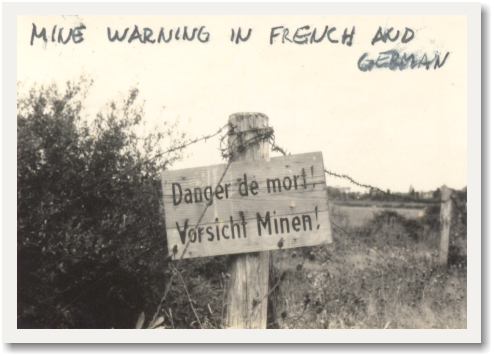Part XII
On 22 February 1945 the 34th Photo and the 111th and the 162nd "TAC R" squadrons of the Provisional "Reece" Group went on a real two-day spree. The compilation of reconnaissance data, both photo and visual, accumulated during this short period was soon to lead to the "breakthrough" of the Siegfried Line Defenses by the Seventh Army. Several thousand square miles of enemy-held territory covering the Siegfried Line Defenses--an area bordering generally from Freiburg south, Stuttgart east, Mannheim and Bad Kreuznach/Kirn north, Sarrbourg and Saarlauten/Saarbrucken west, and Haguenau/Strasburg back to Freiburg south--was the targeted area. A total of 95 missions and 158 sorties were flown to keep the 7th Army in constant and thorough knowledge of movements and concentration of the enemy.

23-February, 1945 - Lt. Phillip Hooke on return from the 1000th mission to be flown by the 34th PRS. Click above to read more about this milestone in the 34th's history! (Phil Hooke) Photo missions provided complete coverage of areas about to be assaulted by the Army; photo strips of the Rhine River and all annexing transportation routes were flown continuously to ascertain serviceability of bridges and supply routes of the Germans; the 34th pilots photographing areas heavily defended by heavy and light anti-aircraft fire and enemy aircraft returned again and again to fly exact flight lines to guarantee solid block coverage of all enemy areas; and in order to overcome the handicap of existing cloud coverage over the target areas all missions were flown at altitudes far below their normal photography level. In addition, and in cooperation with the Third Army, all flight lines in the northern portions of the quadrant area were extended northward even further to provide General Patton previously unavailable priority photography now urgently required.
Our sister 'TAC Recce" pilots maintained a constant complete visual reconnaissance coverage of the entire area. In numerous instances, they called for fighter bombers and then led them to the target. More than 100 enemy aircraft were encountered during the two days.
The "TAC R" boys nailed the lid on with a good old-fashioned "turkey shoot". Seventeen victories, one probable, and five damaged in two days was the official tally--not bad for a "little recce" outfit, The Randerson/Hendricks combination from the war-seasoned 111th led the festivities with a first-day total of at least seven Me 109's destroyed -- probably four more -- and came back the second day to knock off another half dozen or so. This "combo" really knew their business; they were a couple of "pros" that knew each other's moves like two linebackers in the super bowl. When the Luftwaffe tangled with this pair, even with an 18-ship advantage they were really asking for trouble -- they were out-classed and they soon knew it. This two-day tactical reconnaissance air victory total exceeded our Fighter Command's victories for the entire month of February. Believe me, there were some red faces in the fighter camps after this display. It did happen.
March gave us all a much-needed shot in the arm -- the weather, for a change, was much improved and the German front was now being pushed eastward at an accelerated clip. Although increasingly busy a more placid routine was a welcomed addition to the daily squadron schedule. Electricity remained in the air but it was surrounded now with a definite aura of victory.
Yes, things were beginning to losen up. Three-day passes to Paris; seven-day furloughs to England; and extended visitations to the rest areas of Lake d'Annecy in the French Alps and Cannes on the French Riviera were all well received; and Jim Dempsey and Hans Siek, two of the squadron's "steadiest" and our first two pilots to return to the Zone of the Interior for a well-deserved thirty-day period of "R&R", were expected back to the squadron any day. Yes, the pressures were definitely easing.
The 34th got the good word -- it was finally leaving its winter home. On 30 March the 34th advanced units, gear already packed, headed for Y-39, Haguenau. It had been a long, hard winter and the 34th, as promised, had defeated Azelot/Lupecourt, too.
Haguenau, just west of the Rhine River and north of Stausbourg, was one of our better "landings" -- it had everything Azelot didn't...concrete runways, taxiways and hardstands; even hangars all relatively intact; and permanent living quarters, Amen. After only a couple of days the "Unsung Bunch" had already repaired the heating units and had shower facilities functioning.
The Haguenau airfield itself, surprisingly, had suffered little war damage. It had changed hands several times during the winter fighting but it was really only the airdrome perimeter that reflected it. Just off the north end of our main runway was an extensive minefield that had not been "swept". Both metallic and new type plastic mines had been implanted there -- many in the snow. These of course were now lying atop the ground and plainly visable. But to date the engineers in our area did not have the dector gear to properly locate other plastic mines and booby traps suspected. Because of the active minefield dead Germans and US soldiers alike still could be seen lying side by side many with their "winter camouflaged whites" fluttering in the breeze. At one point, immediately adjacent to the airdrome perimeter road a dead American still lay in his fox hole -- Ohio dog tags -- the corpses of three Germans surrounded him.

Minefield warning in French and German. (Lou Cerino) Just a few days following our arrival at Haguenau an American P-47 fighter bomber crash-landed on its belly a couple hundred yards into the minefield without detonating one mine. Despite our screams of warning the pilot also, miraculously, walked from the crash through the field without incident. The engineers, a few days later, finally cleared that same portion and found and deactivated several mines, and a few booby traps on and near some of the bodies. Once again fate had treated our side kindly. The squadron had been at its new base but a week; all the dug-in German Siegfried Line Defenses were breaking down completely; the Allied Armies in all sectors were on the chase in the West; and the Russian Armies were putting on the "bite" in the East. Our pilots were again flying missions at an increased rate. In fact they peaked on 8 April with a fantastic total of "42" -- all in one day; it was the all-time 34th record, and our replacement pilots lead the list in that total. Ah, the sweet smell of victory was close at hand. The Thirty Fourth had come a long way since 19 April when that first mission was flown from Chalgrove, England, almost a year before.
